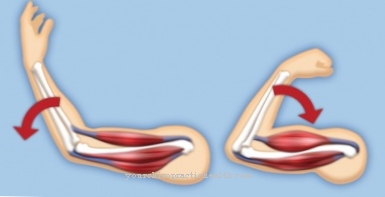The Resting potential is the voltage difference of -70 mV that exists in the non-excited state between the interior and the environment of neurons. The potential is relevant for the formation of action potentials. Cyanide poisoning prevents restoration of the resting potential and leads to neuronal collapse.
What is the resting potential?

The resting potential is the voltage difference that exists between the interior of a non-excited neuron and its surroundings. This difference in voltage must be actively maintained and results from an uneven distribution of sodium and potassium ions.
Two elements of the nerve cell membrane are concerned with maintaining the resting potential: on the one hand, the sodium-potassium pumps and, on the other hand, the ion channels on the Ranvier's cord rings.
The resting potential of excitable nerve cells forms the basis for the saltatory conduction of the human nerve pathways. When excited by an action potential, the cell is depolarized beyond its threshold potential and the voltage-dependent ion channels open, so that when certain ions flow in, the resting potential changes. The action potential is passed on along the nerve pathways through the redistribution of charges.
The resting potential of a human neuron has a difference of -70 to -80 mV. The inside of the cell membrane is negative and the outside is positively charged.
Function & task
Various processes take place on the cell membrane of an excitable cell in the resting phase. On the Ranvier cords, axons are not isolated with myelin. At these nodes, Na + / K + pumps are located, which transport potassium ions into the interior of the axon in the resting phase while consuming ATP. Sodium ions are pumped out of the cell at the same time. Thus there is a higher potassium concentration inside the axons than outside.
Because of the protein-containing ion channels, the membranes of the cells have different levels of permeability for these ions. The sodium channels are usually closed at rest. The channels for potassium, on the other hand, are open, so that the potassium ions diffuse. The ions thus diffuse outwards. This happens until there is a balance between the electrical forces and the osmotic pressure forces. This maintains a charge difference between the outside and inside of the cell membrane, which is also known as the resting potential.
When a stimulus hits a nerve fiber and crosses the threshold, the voltage-dependent sodium and potassium channels open. This creates a depolarization of the cell, which in turn triggers an action potential. The bioelectrical impulse is carried along the nerve fibers.
Put simply, in the case of the action potential, a signal is passed on through the changes in the membrane potential.
A value of -50 mV applies as the threshold value for the development of an action potential. Excitations below +20 mV do not give rise to any action potential and there are no reactions.
After the creation and transmission of an action potential, the N + channels first close again. The K + channels, on the other hand, open so that potassium ions can diffuse out of the axon. The electrical voltage in the interior of the cell drops again. This process is also known as repolarization. Then the K + channels also close and the potential of the cell falls below the resting potential. This hyperpolarization changes into the resting potential, which the sodium-potassium pumps have restored after approx. Two milliseconds. The axon is thus ready for new action potentials.
You can find your medication here
➔ Medicines for paresthesia and circulatory disordersIllnesses & ailments
Phenomena such as cyanide poisoning have life-threatening consequences, some of which are due to the loss of resting potential. The neurons need energy to restore their resting potential. Cyanide poisoning blocks the supply of energy, so that no energy can be provided to restore the resting potential. The nerve cells remain permanently depolarized and lose their functionality.
Depending on how many neurons are affected by an undersupply of energy, the neuronal regulation of the entire organism can collapse in this way. Such a breakdown in neuronal regulation inevitably leads to death.
In a broader sense, complaints with the resting potential of a neuron can also express themselves in ion channel diseases. These hereditary diseases trigger arousal disorders in the muscles and the nervous system. Ion channel diseases influence the switching behavior of the ion channels. Changes in the switching behavior of the channels can, in turn, influence the ability to restore the rest potential. Thus the diseases have an impact on the excitability of the tissue. Ion channel diseases are, in the narrower sense, mutations of the ion channels.
According to scientific findings, three forms of hereditary epilepsy are said to be related to this phenomenon. Hemiplegic migraines and idiopathic ventricular fibrillation are also explained in this way, according to modern research.
The sodium-potassium pumps can also be affected by diseases that affect the resting potential of a nerve cell. According to many scientists, the modern western diet causes an unnatural sodium-potassium ratio in the body. The excess of table salt and a lack of potassium due to too little plant-based food can affect the sodium-potassium pumps, as this can change the intracellular ion ratio.
Genetically determined disorders of the sodium-potassium exchange on the cell membrane, on the other hand, are present in some mutations and have been linked by researchers to forms of epilepsy as well as ion channel diseases. Disturbances in the restoration of the resting potential are therefore probably relevant for various diseases of the central nervous system.













.jpg)

.jpg)
.jpg)











.jpg)